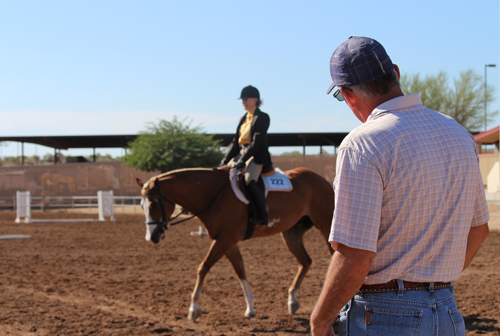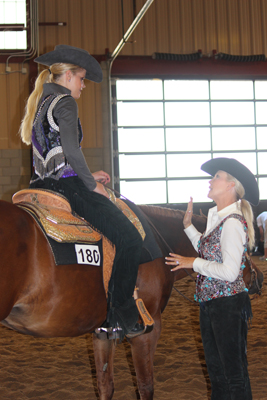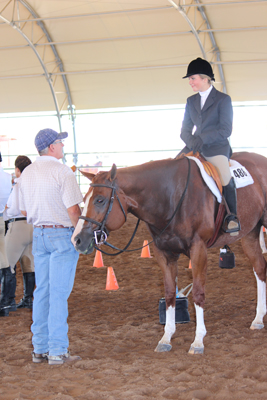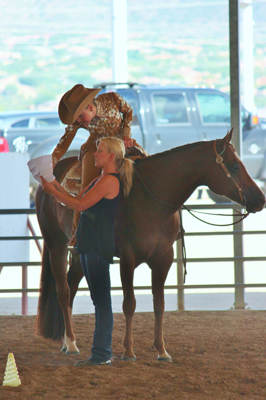 You hear the announcer’s voice asking for the lope, and you hesitate, nervously hoping for a smooth transition. Then the soothing voice comes out of nowhere, urging you to relax and take a deep breath, then ask softly for the lope. You breathe deeply, cueing for the lope as you have a hundred times, as the security of your trainer’s voice wraps around you like a warm blanket. Your horse lopes off like a dream, and you smile, knowing you did it just right.
You hear the announcer’s voice asking for the lope, and you hesitate, nervously hoping for a smooth transition. Then the soothing voice comes out of nowhere, urging you to relax and take a deep breath, then ask softly for the lope. You breathe deeply, cueing for the lope as you have a hundred times, as the security of your trainer’s voice wraps around you like a warm blanket. Your horse lopes off like a dream, and you smile, knowing you did it just right.
It’s hard to describe the magic of the trainer, that person who often somehow becomes your confidant, your cheerleader, your life coach, your go-to-fix-it person when your horse isn’t listening, and maybe most importantly, a teacher who has taught you more than you ever thought possible.
But becoming a great teacher or coach is no simple task, and certified teachers spend years perfecting their skills. So how is it that trainers become experts at getting concepts and skills across to clients? Is it experience, natural talent, or exactly how do they arrive at this pinnacle of training?
InStride Edition went straight to two experts to find out how they have polished the teaching part of the occupation after many years in the industry, and what they have found to be the best techniques: APHA and AQHA Judge and Trainer Brendan Brown of Cave Creek, Arizona, and Teresa Sullivan, Trainer and APHA, ApHC, NSBA and PtHA accredited judge, of Lake Tapps, Washington.
 Ensuring learning isn’t easy for any professional who is responsible for teaching others, but for Brown, understanding the concept of showing his clients how to do something, and then letting them practice, came from his own experiences.
Ensuring learning isn’t easy for any professional who is responsible for teaching others, but for Brown, understanding the concept of showing his clients how to do something, and then letting them practice, came from his own experiences.
“I’m more of a visual learner myself, so most of the time when I’m giving lessons I’m on a horse, and I demonstrate it, and then I talk it through, and then I give them an opportunity to practice it,” he says. “This method became clear to me after I spent a couple of years in Europe and the translation part was pretty sketchy, and you never could be sure if the translator was really translating what you were saying in a form that the people could really understand. So I thought that if people got to see it and then hear about it, they would be more likely to understand. But I must say that doing those clinics in Europe with a translator really refined the way I taught because having to go over there and start from ground zero forced me to be very clear on what I needed to accentuate and the skill sets they needed with the riding.”
Brown’s client, Katrina Pappas, knows this approach is beneficial to her. “He demonstrates maneuvers or drills before having me do them. It helps me visualize what needs to be accomplished,” she says.
Sullivan incorporates the same methods of demonstration and independent practice.
“I’ll run the pattern myself, either riding it or running it if it’s Showmanship, so they (students) understand where to hit their marks. I coach them through it quite a few times and then I’ll be quiet and let them figure it out and self-evaluate,” she says. “Being a judge for the past 15 years has helped me – I train and coach way differently than I did before. I know what’s relevant and what’s not relevant.”
Teach to the Test
Both Brown and Sullivan know that the practice is everything, so both have learned to use sessions at home to directly prepare their clients for the real test, the show pen. For Sullivan, using the rule book, and her experience as a judge, is logical. “I teach my clients the scores and the rules of the event. They have to know the rule book, on that particular event scored. I show them where the penalties are, where the hypotheticals are, where you can go wrong, and where you can go right. Then as they practice, I’ll score the pattern and I call out the penalty they get, or the plus score they earned. I’ve also found that if we work together as a team, they can watch each other as clients ride and see the reasons for the scores,” she explains.
Sullivan’s client, Lisa Stone, accredits the practice with a great deal of growth for her as a rider, “Every lesson, I grow, even after 20 years of showing. Because she’s a judge, when we practice and when we show a scored event, she’ll tell us how we would have been judged. At home we’ll fill out score sheets, and when we show she’ll go through it with us, and tell us what she would have scored, and we also score others at the show. It’s a different perspective, we’re really aware of where we can plus, where our strengths and weaknesses are.”
Brown finds that another way to approach preparing for the rigor of the ring is to help his riders develop skills that become part of their rote memory and foundation, so they can rely on the skill without thinking. He reveals, “I actually use a lot of drills because I think people really need repetition, and it helps when you break it down and work on one specific thing rather than trying to do a whole bunch of things at once. I’ll set up cones and have patterns and have them working on collection and transitions. There are basic horsemanship skills that have to become ingrained so it becomes part of their muscle memory and something that doesn’t require conscious thought.”
 Getting Unstuck
Getting Unstuck
“I will video tape them, and the clients love it,” shares Sullivan, when asked how she addresses a difficult concept they can’t get past, or when she wants to change a habit, or teach a new skill. “They love this strategy because they learn from the minor mistakes. They want to know how it looks, and I really believe it’s a good tool to have.” She explains using video also positively motivates her clients, too. “If I take a video of them last year or the beginning of the season, and they can see the progress they’ve had, they feel better about it, and we can even laugh later at our bloopers.”
“What has been helpful to me with it is to just talk to my peers about it,” Brown discloses. “It’s interesting because you feel like you’re the only one facing this roadblock, but a lot of times other people are, too. Usually by talking to the other trainers about it, you can come up with different methods to get your client through it, because it’s possible for riders to create a mental roadblock, and if we spend our energy focusing on that one issue, they can’t go forward. I was wrestling with one of those problems, and someone told me to break it down and give the client an attainable goal for that day, such as, “Today I will get my left diagonal.” With horse training you have to break it down to its simplest form for it to come together. That depressurizes the whole situation where the person can have a goal, attain it and move on.”
Since trainers spend each day, after years of doing so, on a horse’s back, one might wonder how they possibly could relate to a client or put themselves in his or her place, especially when it comes to a novice rider. “As a trainer that’s your biggest struggle, and that’s something that I have to work on all the time, because there are so many different ways to say the same thing, or get through the same process, it’s a constant learning curve for me,” says Brown, who again applies the practice of relying on his peers if he needs to, understanding they may have a different skill set than he does.
“There are several people I admire as coaches that I really like to learn from, and I try to add it to what I do. I think as an all-around trainer, you’re trying to be an expert on everything and that’s really difficult. To get my people where they need to go, a lot of times I’ll bring in someone else that I think has a better approach on that event. Holly Hover helps my clients with the Showmanship, Carolyn Rice has come in several times and done clinics for us to help with Equitation. They feel as passionate about that event as I do about Western Riding and Trail. Sometimes they are telling the clients the same thing, but it’s a different approach. I think coaching is the biggest challenge to the training process really, because trying to get the people to the point where they get competitive can be a bigger challenge than the horse itself.”
 One way that Sullivan can provide the same results for all levels of clients, despite that challenge, is by keeping consistency in the horse’s training first and foremost. “I try to put the same buttons on all my horses, and make sure the foot pedals all work the same. I do a one, two, three for leg aids; one is right behind the cinch, two is bringing it back to the ribcage, and three is engaging the hock. So when they hear me say hit the three buttons on the leg aids, for example, clients all understand it. It’s just easiest for everyone to break it down that way.”
One way that Sullivan can provide the same results for all levels of clients, despite that challenge, is by keeping consistency in the horse’s training first and foremost. “I try to put the same buttons on all my horses, and make sure the foot pedals all work the same. I do a one, two, three for leg aids; one is right behind the cinch, two is bringing it back to the ribcage, and three is engaging the hock. So when they hear me say hit the three buttons on the leg aids, for example, clients all understand it. It’s just easiest for everyone to break it down that way.”
Since there is a gap between Sullivan’s riding expertise and that of her clients’, though, she has learned to use collaboration between clients as a powerful tool to reach across various levels, much like any modern educator would. Client Sharon Rich explains, “If we observe something, then we share it in a positive manner. We always watch each other’s warmup, so you can go in there and have a kind of shared confidence.”
Yet the biggest ah-ha moment for Brown in regard to understanding how his clients feel and learn changed his perspective and teaching when he was in his 30s. “I’ve been showing since I was 9, and I started showing Reiners fairly late, so I was probably 30-something when I started showing them. I was so shocked at how fast the class seemed to go! I was just going maneuver to maneuver, and I couldn’t remember if I had done everything. And I suddenly realized it was exactly how my customers feel, when it seems as if you don’t have time to think in the Western Riding and Trail. It was a good lesson to remind me when they start doing these events and feel like they are reacting instead of having a plan.”
When asked if the client has to be part of the team effort and take part of the responsibility, Brown affirms the importance of participation.
“It takes a certain amount of hours of practice, and not just riding, but practice at getting better to master any sport, and it takes a certain level of fitness to be good at this. Those two factors influence how successful somebody is.”
Sullivan applies the teamwork principle to her expectations of her barn, asking them to work together and not just be passive learners.
“It goes back to being a team, and they’ll jump in and help and act as the judges during a lesson, or work with each other on the Showmanship pattern,” she explains. “I’ll make them stand where the judges are going to be sometimes, but what’s really a big help for them is when I try to bring one of my amateurs with me as a ring steward.”
When it all really is said and done, however, the client perspective is pivotal. What Sullivan’s clients love about her teaching is the depth and positive approach to instruction. “I can feel things and they bother me but I don’t always know how to fix them,” says Lisa Stone. “She can always tell me why – if my mare’s dumping her shoulders, she asks if I feel it and explains why I need to fix it the way she’s telling me. She’s really good about telling you what you’re doing right first, and then telling you what you need to work on. I never feel berated.”
Sharon Rich agrees, “Teresa never criticizes; she simply tells me what to do, in a really upbeat way. We can have a correction, but she taught me how to recognize when my horse is trying, and to tell my horse she’s good. I think that’s part of what makes the program.”
Much like Sullivan’s clients, Brown’s customer, Katrina Pappas, appreciates the positive tactics he employs.
“First of all, Brendan uses a positive approach. In addition to explaining what needs improvement and how, he tells me what is going well,” she says. “Brendan also has a very calm and patient approach to instructing his students. He’s told me several things at least a hundred times until I finally understood and applied them, such as more leg, less rein. His tone did not change between the first and the 100th time. His calm demeanor creates an exceptional learning and showing environment for me and my horse.”



You must be logged in to post a comment Login